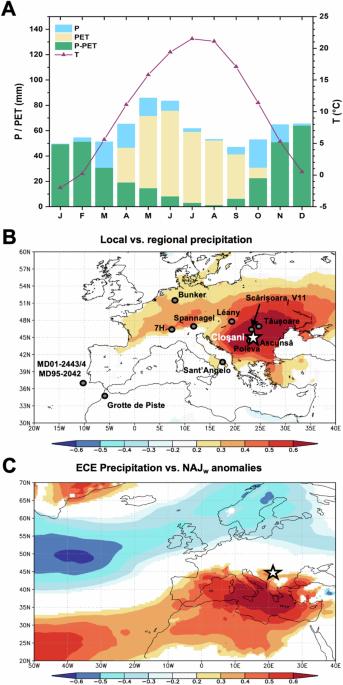Dynamic processes determine precipitation variability in Eastern Central European since the Last Glacial Maximum
IF 8.1
1区 地球科学
Q1 ENVIRONMENTAL SCIENCES
引用次数: 0
Abstract
The response of European precipitation variability to climate change is still poorly understood. Here we present a high-resolution speleothem record of Eastern Central European (ECE) autumn/winter precipitation to study decadal to centennial hydroclimatic variations in the European-Atlantic sector since the Last Glacial Maximum. The Cloşani Cave δ18O record shows that the reorganization of the North Atlantic jet following the demise of the Northern Hemispheric ice sheets lasted until c. 6000 to 5000 years before present. Trace element-derived semi-quantitative autumn/winter precipitation amount reveals that the late Glacial and the early to mid-Holocene experienced about 20–30% higher precipitation than present. During the deglaciation, we detect an increased decadal to centennial precipitation variability decoupled from millennial-scale North Atlantic temperature changes. The findings suggest that dynamic (rather than thermodynamic) processes determine regional precipitation variability and the probability of extreme precipitation events in ECE, highlighting the importance of understanding such dynamics for future predictions. Dynamic atmospheric processes like the North Atlantic jet stream determine the variability of precipitation in Eastern Central Europe, according to analysis of a precipitation record derived from stalagmite trace elemental data from the last twenty thousand years.

末次冰川极盛时期以来中欧东部降水量变化的动态过程
人们对欧洲降水变化对气候变化的响应仍然知之甚少。在此,我们展示了东中欧秋冬季降水的高分辨率岩浆记录,以研究欧洲-大西洋地区自末次冰川极盛时期以来十年至百年的水文气候变迁。克洛萨尼洞穴δ18O记录显示,北半球冰盖消亡后北大西洋喷流的重组一直持续到距今约6000至5000年前。痕量元素半定量秋冬季降水量显示,冰川晚期和全新世早中期的降水量比现在高出约 20-30%。在冰河时期,我们发现十年至百年降水量变化的增加与千年尺度的北大西洋温度变化脱钩。研究结果表明,动态过程(而非热力学过程)决定了欧洲经委会的区域降水变率和极端降水事件的发生概率,突出了了解这种动态过程对未来预测的重要性。根据对过去两万年石笋痕量元素数据得出的降水记录的分析,北大西洋喷流等动态大气过程决定了中东欧降水的变异性。
本文章由计算机程序翻译,如有差异,请以英文原文为准。
求助全文
约1分钟内获得全文
求助全文
来源期刊

Communications Earth & Environment
Earth and Planetary Sciences-General Earth and Planetary Sciences
CiteScore
8.60
自引率
2.50%
发文量
269
审稿时长
26 weeks
期刊介绍:
Communications Earth & Environment is an open access journal from Nature Portfolio publishing high-quality research, reviews and commentary in all areas of the Earth, environmental and planetary sciences. Research papers published by the journal represent significant advances that bring new insight to a specialized area in Earth science, planetary science or environmental science.
Communications Earth & Environment has a 2-year impact factor of 7.9 (2022 Journal Citation Reports®). Articles published in the journal in 2022 were downloaded 1,412,858 times. Median time from submission to the first editorial decision is 8 days.
 求助内容:
求助内容: 应助结果提醒方式:
应助结果提醒方式:


